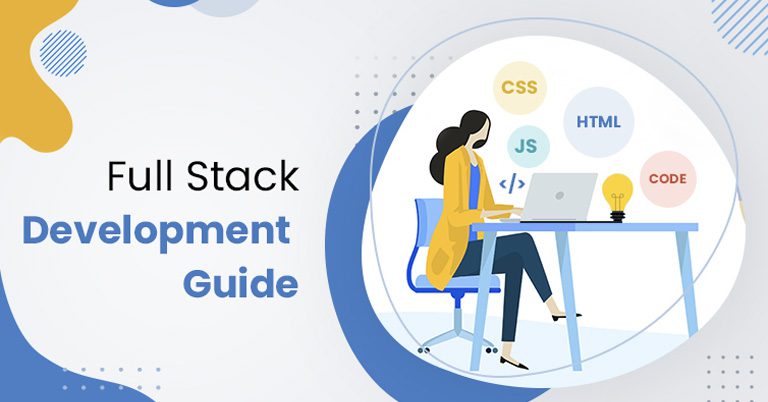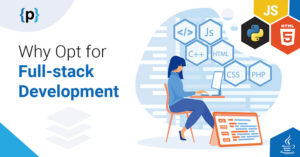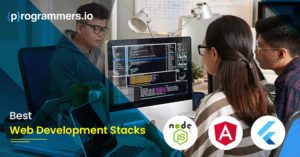Full-stack development is a term used to describe the practice of building software applications that involve both client-side and server-side programming. Full-stack developers are professionals who have knowledge and experience in all layers of software development, including front-end development, back-end development, and database management.
Front-end development refers to the design and development of the user interface, which includes the layout, design, and functionality of the user interface. Back-end development, on the other hand, involves the development of server-side applications, including programming languages, databases, and web servers. Database management includes the design, creation, and management of databases.
Full-stack developers are responsible for understanding and implementing all aspects of software development, from the user interface to the back-end server-side applications. They are proficient in various programming languages, such as HTML, CSS, JavaScript, Java, Ruby, Python, and more. They are also familiar with various frameworks and libraries, such as React, Angular, Vue, Node.js, and more.
Full-stack developers work on various projects, from simple web applications to complex software applications that require large databases and complex server-side applications. They are versatile professionals who can work on different aspects of a project, from design to development, testing, and deployment.
Read: MEAN and MERN Full Stack Development
Technologies in Full Stack Development
Full stack development typically involves the use of a variety of technologies, including:
- Front-end technologies: These include HTML, CSS, and JavaScript, as well as popular front-end frameworks like React, Angular, and Vue.js.
- Back-end technologies: These include programming languages such as Java, Python, Ruby, and PHP, as well as web development frameworks like Ruby on Rails, Django, and Laravel.
- Databases: Full stack developers work with databases to store and retrieve data. Common databases used in full stack development include MySQL, MongoDB, and PostgreSQL.
- Server-side technologies: Full stack developers use server-side technologies like Node.js and Apache to manage server-side code and interact with databases.
- API development: Full stack developers may also work on developing APIs to enable communication between different applications or services.
- DevOps tools: Full stack developers may use DevOps tools like Docker and Kubernetes to manage infrastructure and automate the deployment process.
Overall, a full stack developer should have knowledge and experience in a variety of these technologies in order to develop end-to-end web applications.
Read: Backend vs Frontend vs Full Stack Developers
Looking for a Full Stack Development Team?
Hiring a full stack development team is an important decision that requires careful consideration. It involves identifying the specific skills and expertise you need, determining the staffing needs, partnering with a reputable company, and conducting thorough interviews and technical assessments. However, with the rise of staff augmentation services, companies can now more easily hire staff members with the required skill sets without having to invest in the time and resources required for traditional hiring processes. In this guide, we will provide a step-by-step process to help you hire a full stack development team using staff augmentation services.
Full Stack Developers – Staff Augmentation:
- Assess your project requirements: Before considering hiring, assess your project requirements to determine the specific skills and expertise you need. This includes identifying the technology stack, project scope, and timeline.
- Determine the staffing needs: Based on the project requirements, determine the number of staff members and specific skill sets required to complete the project effectively. This will help you identify the specific roles and responsibilities you need to fill.
- Partner with a reputable company: Partner with a reputable company that can provide the necessary staff members with the required skill sets. Work with the company to create a job description that outlines the specific requirements and expectations for each role.
- Shortlist candidates: Once the job description is posted, the company will shortlist candidates based on their skills and experience. They will conduct initial interviews to assess technical skills and communication abilities.
- Conduct technical assessments: After the initial interviews, conduct technical assessments to test the candidate’s skills and knowledge in the relevant technology stack. This can include coding tests, debugging exercises, and project-based assignments.
- Conduct final interviews: Based on the technical assessments, the company will shortlist the candidates who meet your requirements and conduct final interviews. This is your chance to assess their soft skills, work culture fit, and overall experience.
- Select candidates and finalize the contract: Once you have identified the ideal candidates, the company will finalize the contract terms and provide you with the necessary paperwork. This includes discussing the rate, contract terms, and other benefits.
- Onboard the staff members: Once the contract is finalized, onboard the staff members. Provide them with access to the necessary tools, resources, and documentation to get started on the project.
- Set up a project management system: Finally, set up a project management system to ensure effective communication, collaboration, and project delivery. This can include using tools to track progress, assign tasks, and manage deadlines.
Hiring a full stack development team is a complex process that requires careful consideration of project requirements, staffing needs, and candidate qualifications. By partnering with a reputable company that provides staff augmentation services, you can more easily and efficiently hire staff members with the required skill sets. This guide has outlined a step-by-step process to help you hire a full stack development team using staff augmentation services. By following these steps, you can effectively fill the skill gaps in your team and complete your project on time and within budget.




